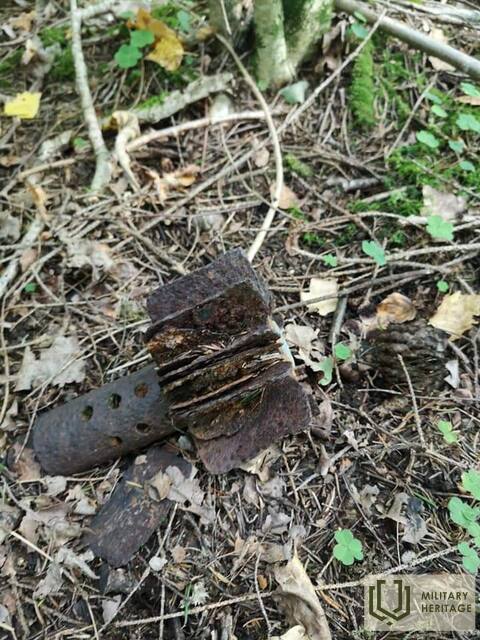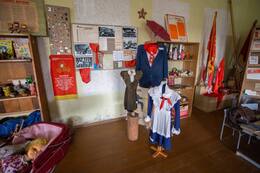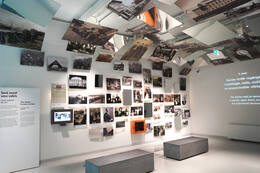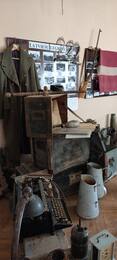Išdaigos ir žaidimai su karine amunicija
Po Antrojo pasaulinio karo Latvijos žemė buvo pilna fizinių karo liekanų. Tai buvo daugybė sviedinių, nesprogusių minų ir tiesiog šovinių. Net ir dabar, ypač tose vietose, kur vyko aktyvūs karo veiksmai, randama nesprogusių minų, o tai yra didelė retenybė, o pokario metais šie sviediniai buvo miškų ir net kiemų gyventojų kasdienio gyvenimo dalis, netgi vaikų žaislai.
Mudu su kaimynų berniukais buvome rimtai susižavėję ir artilerijos sviedinių, ir minų, ir detonatorių paieška. Ten tempėme sunkius. Su kaimynais mažesnius laužėme, bet didesnius reikėjo atsargiai prisukti, jei į ką nors pataikysi, įvyks sprogimas. Juos deginome, jei pataikysi, jie sprogo, bet juos buvo galima sudeginti.
Tada praleidome mokyklą ir ėjome į mišką rinkti šovinių, ten buvo daug žemių, rankomis pašalinome šiek tiek samanų, ir viskas buvo pilna. Taip pat ieškojome minų, jos buvo geros, jau žinojome, kur yra detonatorius, kaip jį atsukti. Tada turėjome tokių gudrybių, buvo Rygos-Maskvos geležinkelio linija. Surinktus šovinius dėdavome ant bėgių, ir kai traukinys pravažiuodavo, pasigirsdavo vienas trenksmas po kito. Traukiniui nieko neatsitiko, bet trenksmai buvo garsūs. Vienu metu traukinys buvo sustabdytas, o tada ir mus pagavo policija, nors kažkas jau buvo matęs, ką mes ten veikėme, tada jie išsivežė viską, ką buvome surinkę.
Aš irgi buvau namuose daug tų šovinių laikiusi, bet mamai jie nepatiko ir kiekvieną kartą, kai juos rasdavo, atimdavo juos iš manęs ir įmesdavo į tvenkinį. Radome ir lėktuvų patrankų sviedinių, buvo viena ypač pelkėta vieta, kur vaikščiodavome su metaliniu strypu ir baksnodavome žemę, o kai pataikydavome į metalą, juos iškasdavome. Kartą mums labai pasisekė, nes metaliniu strypu buvau įsmeigęs tik mažą minos detonatoriaus gabalėlį, jei jis būtų pataikęs, būtų įvykęs sprogimas. Po to su kaimynų berniukais iškasėme duobę, pripildėme ją visokių surinktų sviedinių, kurie dažniausiai buvo nesprogę, taip pat sudėjome lėktuvų patrankų sviedinius, juos jau buvome ištyrę ir sudėlioję taip, kad kažkas degtų ir sprogtų. Bet tada viskas įvyko taip, kaip nesitikėjome, viskas pradėjo sprogti. Atvyko policija ir ugniagesiai gelbėtojai, bet mes jau buvome nuėję ir stebėjome iš krūmų. Jie visai nepriartėjo, laukė, kol ugnis ir sprogimai nurims. Tada nepasirodydavau namuose iki sutemų, slėpdavausi. Tada buvo vienas klasiokas, su kuriuo aptikome netikėtų minų, jas pakėlėme ir vėl įmetėme į ugnį, taip pat buvo gerų sprogimų, ir net tada ilgai negrįždavome namo. Tai buvo mums labai aktuali tema.
Paskui, kai buvau vyresnis ir dirbau Karo komisariate, mus iškvietė, nes buvo rasta nesprogusi bomba. Nuvažiavome ir iškvietėme sapierus, bet jų teko laukti taip ilgai, kad su kolega nusprendėme patys nuvežti miną į karinio komisariato pastatą. Jis vairavo mopedą, o aš sėdėjau priekaboje, mina buvo man ant kelių, detonatorius nukreiptas į viršų, kad nesprogtų. Ramiai nuvežėme miną per visą Rygą, o sapierai priėjo prie mūsų, ją surinko ir išsivežė, nes vėliau mums padėjo vaikystės žaidimai.
Susijusi laiko juosta
Susijusios vietos
Tirzos parapijos kraštotyros muziejuje eksponuojama SSRS laikotarpio istorinių įrodymų paroda.
Paroda, įsikūrusi buvusio kolūkio dispečerio kambaryje, buvo atidaryta 2005 m. Lankytojai kviečiami patirti SSRS atmosferą interaktyviose pamokose: aptarti sovietmetį, kurti legendas apie istorinius įrodymus, dalyvauti choriniame dainavime, šokti „letkius“, gaminti popierinius lėktuvėlius ir člapuškas, taip išgyvenant pertrauką mokykloje, taip pat mėgautis kilavu bandelėmis ir liepžiedžių arbata.
Pasakojimai ir istoriniai įrodymai apie tradicijas, senovinius amatus ir iškilius vietos žmones.
Prašome užsisakyti vizitą iš anksto!
Suaugusiesiems: 2,00 Eur
Studentams, pensininkams: 1,00 Eur
Ekskursija su gidu iki 6 žmonių (1-1,5 val.): 6,00 Eur
Ekskursijos su gidu daugiau nei 6 asmenims (1–1,5 val.): 1,00 Eur asmeniui
Latvijos okupacijos muziejus
Muziejuje eksponuojama Latvijos istorija nuo 1940 iki 1991 m., nacistinės Vokietijos ir Sovietų Sąjungos okupacijos laikotarpiu. „Ateities namai“ – tai žinomo Amerikos latvių architekto Gunāro Birkertaus suprojektuoto Okupacijos muziejaus rekonstrukcijos ir išplėtimo projektas, taip pat nauja muziejaus ekspozicija. Ekspoziciją „Čekos istorija Latvijoje“ sukūrė Okupacijos muziejus, ji yra buvusiame SSRS Valstybės saugumo komiteto (KGB) pastate „Kampiniame name“. Latvijos okupacijos muziejus buvo įkurtas 1993 m. Jis pasakoja ilgai slėptą Latvijos valstybės, tautos ir žemės likimo istoriją dviejų užsienio totalitarinių valstybių okupacijos laikotarpiu nuo 1940 iki 1991 m. 2020 m. pabaigoje muziejuje buvo daugiau nei 70 000 įvairių istorinių eksponatų (dokumentų, nuotraukų, rašytinių, žodinių ir daiktinių įrodymų, daiktų ir atminimo dovanų). Muziejaus specialistai įrašė daugiau nei 2400 vaizdo įrašų, todėl tai viena didžiausių okupacijos kolekcijų Europoje. Latvijoje, Lietuvoje ir Estijoje klostęsi įvykiai aiškiai parodo, ką tautoms teko ištverti valdant dviem totalitariniams režimams.
Latvijos karo muziejus
Latvijos karo muziejus yra įsikūręs senamiestyje, netoli Laisvės paminklo, istoriniame gynybos pastate, vadinamame „Parako bokštu“. Muziejuje yra 11 eksponatų. Čia eksponuojami įvairūs ginklai, dokumentai, uniformos, apdovanojimai, ženkleliai ir kiti daiktai, pasakojantys apie kasdienį kareivio gyvenimą kare. Latvijos karo muziejus yra vienas seniausių muziejų Latvijoje. Jo ištakos siekia Pirmąjį pasaulinį karą. Muziejaus kolekciją daugiausia sudarė asmeniniai kareivių daiktai arba mūšio laukuose rasti daiktai. Latvijai atgavus nepriklausomybę, pagrindinis muziejaus tikslas tapo sukurti ekspoziciją apie Latvijos karo istoriją ir aktyvų gyventojų vaidmenį saugant savo žemę. 1937 m. muziejus buvo išplėstas ir techniškai buvo vienas moderniausių tuo metu Europoje. Parako bokštas buvo vienas iš Rygos įtvirtinimų bokštų. Kai kurie įrodymai siekia 1330 m., kai jis buvo minimas kaip „Smėlio bokštas“. Bokštas buvo sugriautas 1621 m., kai Rygą apgulė Švedijos armija. Tačiau 1650 m. buvo pastatytas naujas bokštas parakui ir ginklams laikyti. Nugriovus miesto įtvirtinimus, Parako bokštas išlieka vienu svarbiausių Rygos gynybos sistemos įrodymų.
Privati karinė kolekcija Mundigciems mieste
Privati karinė kolekcija Mundigciemse. Aivaras Ormanis jau daugelį metų kolekcionuoja istorinius objektus – karines uniformas, uniformas, maskuojamuosius drabužius, ryšio priemones, namų apyvokos daiktus, apsaugos priemones iš įvairių laikotarpių ir šalių, datuojamus Antruoju pasauliniu karu, sovietų armija ir nepriklausomos Latvijos atkūrimu.
Šiuo metu kolekcija nėra gerai prižiūrima, o eksponatai saugomi buvusiame kolūkio tvarte.










